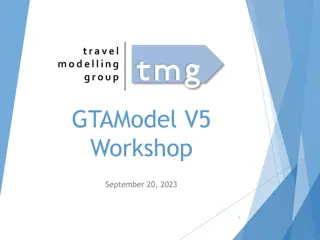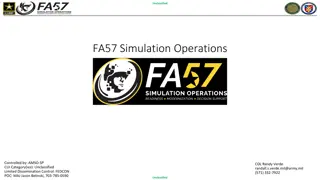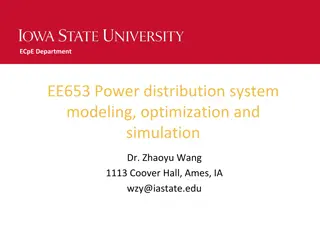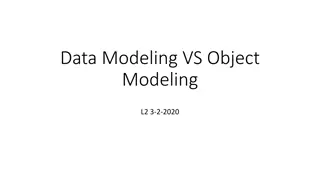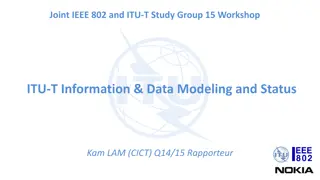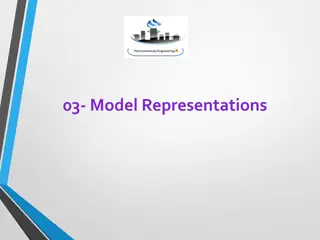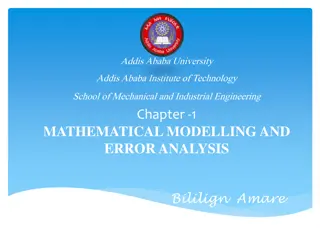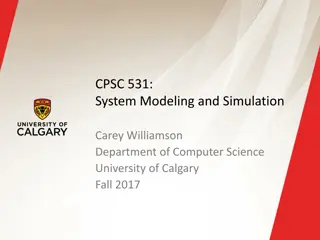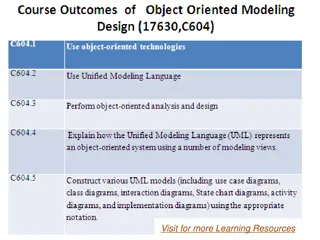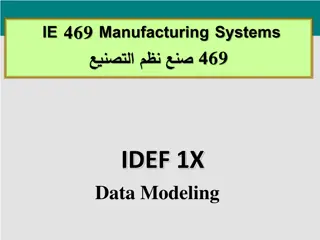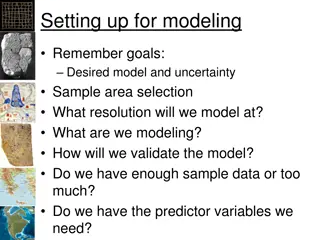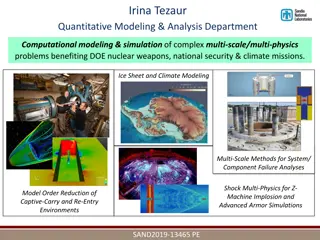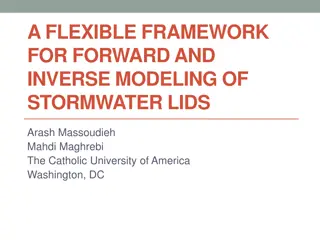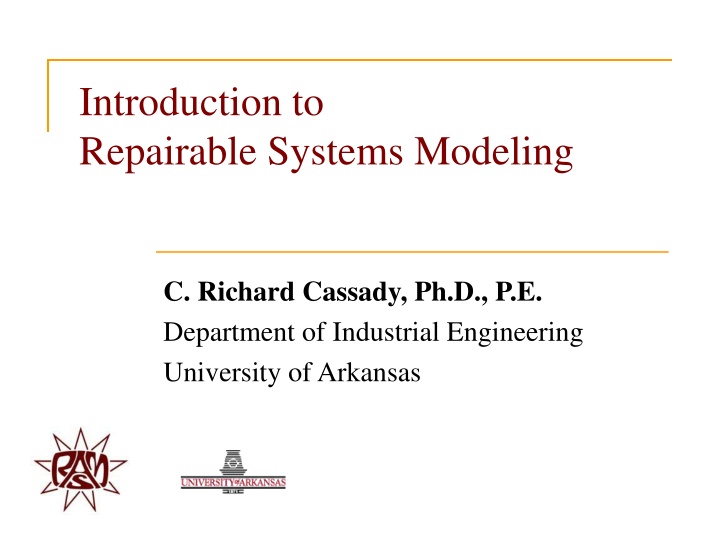
Repairable Systems Modeling
Repairable systems modeling involves applying operations research techniques to evaluate and design maintenance policies for equipment. This entails understanding repairable systems, various types of maintenance actions, and performance measures. With a focus on restoration after failure through maintenance actions, repairable systems play a crucial role in ensuring system functionality and reliability.
Download Presentation

Please find below an Image/Link to download the presentation.
The content on the website is provided AS IS for your information and personal use only. It may not be sold, licensed, or shared on other websites without obtaining consent from the author. If you encounter any issues during the download, it is possible that the publisher has removed the file from their server.
You are allowed to download the files provided on this website for personal or commercial use, subject to the condition that they are used lawfully. All files are the property of their respective owners.
The content on the website is provided AS IS for your information and personal use only. It may not be sold, licensed, or shared on other websites without obtaining consent from the author.
E N D
Presentation Transcript
Introduction to Repairable Systems Modeling C. Richard Cassady, Ph.D., P.E. Department of Industrial Engineering University of Arkansas U of A Logo
Overview What is a repairable system? Repairable system models based on renewal theory. Repairable system models based on the concept of minimal repair. Repairable system models based on the concept of imperfect maintenance. Advanced topics in repairable systems modeling. 2010 RAMS Tutorial 11B Cassady 2
What is a repairable system? definition of a repairable system types of maintenance actions definition of repairable systems modeling repairable system performance measures a repairable systems taxonomy 2010 RAMS Tutorial 11B Cassady 3
Definition A repairable system (RS) is a system which, after failure, can be restored to a functioning condition by some maintenance action other than replacement of the entire system. modified version of definition from Ascher and Feingold (1984) replacing the entire system is an option, but not the only option 2010 RAMS Tutorial 11B Cassady 4
Types of Maintenance Actions corrective maintenance (CM) action response to failure could be repair, could be replace preventive maintenance (PM) action not in response to failure intended to delay or prevent failure may (not) be cheaper/faster than a CM action could be repair, could be replace not operational maintenance (putting gas in your car) 2010 RAMS Tutorial 11B Cassady 5
Types of PM Actions scheduled maintenance (SM) PM actions are scheduled based on some measure of elapsed time my focus today condition-based maintenance (CBM) PM actions are initiated based on data generated from sensors applied to the system no wasted operational time (JIT maintenance) still a developing science 2010 RAMS Tutorial 11B Cassady 6
Repairable Systems Modeling Repairable systems modeling refers to the application of operations research techniques to problems related to equipment maintenance. evaluating the performance of one or more RS designing maintenance policies for one or more RS 2010 RAMS Tutorial 11B Cassady 7
Repairable System Operation The RS of interest (and any components or subsystems that comprise the RS) is always in one of two states. functioning (up) down (for CM or PM) 1 if functionin is system at time g t ( ) t = X 0 if system is down at time t 2010 RAMS Tutorial 11B Cassady 8
Repairable System Operation initiation of a maintenance action X(t) 1 0 0 completion of the maintenance action t 2010 RAMS Tutorial 11B Cassady 9
RS Performance Measures number of failures availability measures cost measures 2010 RAMS Tutorial 11B Cassady 10
Number of Failures N(t) = # of system failures in the first t time units of system operation because of the stochastic nature of failures and maintenance actions, N(t) is a random variable may focus on: E[N(t)] Var[N(t)] probability mass function of N(t) 2010 RAMS Tutorial 11B Cassady 11
Availability Measures Availability can be loosely defined as the proportion of time a system is in a functioning condition. However, there are four specific availability measures found in the RS literature, all based on X(t). 2010 RAMS Tutorial 11B Cassady 12
Availability Measure #1 the availability function ( ) t A 1 = ( ) t = Pr X often difficult to obtain rarely implemented 2010 RAMS Tutorial 11B Cassady 13
Availability Measure #2 limiting availability ( ) t = lim A A t often easy to obtain most commonly-used measure may not exist 2010 RAMS Tutorial 11B Cassady 14
Availability Measure #3 the average availability function T 1 ( ) T ( ) t 0 = A A dt avg T often difficult to obtain rarely implemented, but a valuable measure 2010 RAMS Tutorial 11B Cassady 15
Availability Measure #4 limiting average availability =lim ( ) t A A avg avg t very often equivalent to limiting availability rarely used 2010 RAMS Tutorial 11B Cassady 16
Cost Measures Cost functions are often used to evaluate the performance of a RS. The form of the cost function depends on the characteristics of the RS of interest. However, these functions typically include certain cost parameters. 2010 RAMS Tutorial 11B Cassady 17
Cost Function Parameters cf = cost of a failure cd = cost per time unit of downtime cr = cost (per time unit) of CM cp = cost (per time unit) of PM ca = cost of replacement 2010 RAMS Tutorial 11B Cassady 18
A Repairable System Taxonomy Consider a RS that: is modeled as a single component or black box is intended to function 24/7 has self-announcing failures is binary-state is as good as new at t = 0 is subjected to either no PM or scheduled PM 2010 RAMS Tutorial 11B Cassady 19
A Repairable System Taxonomy Such a system can be summarized by: 1 / 2 / 3 / 4 / 5 / 6 where 1 time to first failure 2 duration of CM 3 impact of CM 4 type of PM 5 duration of PM 6 impact of PM 2010 RAMS Tutorial 11B Cassady 20
RS Models Renewal Theory generic case the G/G/P model a special case the CFR/E/ model two numerical examples PM optimization the W/G/P/A/G/P model 2010 RAMS Tutorial 11B Cassady 21
The G/G/P Model the 1st G the time to first failure is a random variable the 2nd G the duration of CM is a random variable P CM restores the RS to an as good as new condition (CM is perfect) no last three no PM is performed 2010 RAMS Tutorial 11B Cassady 22
G/G/P Mathematical Notation Ti = duration of the ith interval of RS function T1, T2, is a sequence of iid random variables result of the as good as new assumption Di = duration of the ith CM action D1, D2, assumed to be iid 2010 RAMS Tutorial 11B Cassady 23
G/G/P Why Renewal Theory? Each cycle of RS function/CM has identical probabilistic behavior. Therefore, the completion of a CM action is a renewal point for the stochastic process {X(t), t 0}. 2010 RAMS Tutorial 11B Cassady 24
G/G/P General Results ( ) E + E T MTTF + = = i A ( ) T ( ) D E MTTF MTTR i i ( ) ) E uptime + = A ( ( ) E uptime E downtime 2010 RAMS Tutorial 11B Cassady 25
A Special Case The CFR/E/ Model CFR the time to first failure is an exponential random variable having rate , i.e. the RS has a constant failure rate (MTTF = 1/ ) E the duration of CM is an exponential random variable having rate (MTTR = 1/ ) Since the RS has a constant failure rate, the impact of CM is irrelevant. The CFR/E/ model is a special case of the G/G/P model. 2010 RAMS Tutorial 11B Cassady 26
CFR/E/ Results + + ( ) t ( ) + = + t A e + = A 1 ( ) ( ) + + + T e T ( ) T = A ( ) T avg 2 + 2010 RAMS Tutorial 11B Cassady 27
CFR/E/ Numerical Example #1 communication relay = 0.001 failures per hr MTTF = 1000 hr = 0.025 repairs per hr MTTR = 40 hr 1000 = = 9615 . 0 A + 1000 40 2010 RAMS Tutorial 11B Cassady 28
CFR/E/ Example #1 1 A(t) 0.99 0.98 0.97 t 100 200 300 400 500 2010 RAMS Tutorial 11B Cassady 29
CFR/E/ Example #1 1 Aavg(T) 0.99 0.98 0.97 T 500 1000 1500 2000 2010 RAMS Tutorial 11B Cassady 30
G/G/P Numerical Example #2 motor Ti ~ Weibull( = 2, = 1000 hr) t ( ) t ( ) = = Pr exp R T t i 1 = + = 1 886 2 . hr MTTF 2010 RAMS Tutorial 11B Cassady 31
G/G/P Example #2 Di ~ Normal( = 25 hr, = 5 hr) MTTR = 25 hr 886 2 . + = = 9726 . 0 A 886 2 . 25 Availability or average availability values can be estimated using simulation. 2010 RAMS Tutorial 11B Cassady 32
The W/G/P/A/G/P Model W the time to first failure is a Weibull random variable having > 1 A the RS is subjected to an age-based PM policy if the RS functions without failure for time units, a PM action is initiated the 2nd G the duration of PM is a random variable the 2nd P PM restores the RS to an as good as new condition (PM is perfect) 2010 RAMS Tutorial 11B Cassady 33
W/G/P/A/G/P PM Optimization conditions under which PM may be worthwhile: the RS has an increasing failure rate (IFR) PM reduces the age of the equipment PM is cheaper and/or faster than CM 2010 RAMS Tutorial 11B Cassady 34
W/G/P/A/G/P PM Optimization T = duration of an interval of RS function f(t) = pdf of T F(t) = cdf of T DPM = duration of a PM action DCM = duration of a CM action 2010 RAMS Tutorial 11B Cassady 35
W/G/P/A/G/P PM Optimization Since both CM and PM renew the RS: ( ) ) E uptime + = A ( ( ) E uptime E downtime We can derive E(uptime) and E(downtime) by conditioning on the value of T. 2010 RAMS Tutorial 11B Cassady 36
W/G/P/A/G/P PM Optimization Function if T > T if T DCM DPM PM CM 2010 RAMS Tutorial 11B Cassady 37
W/G/P/A/G/P PM Optimization ( ) ( ) t ( ) = + 1 E uptime tf dt F 0 ( ) ( ) ( ) F ( ) ( ) = + 1 E downtime E D E D F CM PM The integral in E(uptime) has to be evaluated numerically. 2010 RAMS Tutorial 11B Cassady 38
PM Optimization Example compressor T ~ Weibull( = 2, = 80 hr) E(DPM) = 2 hr E(DCM) = 8 hr Using a mathematical analysis software package (e.g. Mathematica), we can plot limiting availability as a function of . 2010 RAMS Tutorial 11B Cassady 39
PM Optimization Example A 0.918 0.916 0.914 40 50 60 70 optimal value of = 47.5 hours maximum limiting availability = 0.9182 2010 RAMS Tutorial 11B Cassady 40
RS Models Minimal Repair generic case the G/0/M model the Poisson process the CFR/0/ model the power law process the W/0/M model replacement optimization the W/0/M/B/0/P model 2010 RAMS Tutorial 11B Cassady 41
The G/0/M Model 0 CM is instantaneous M CM is minimal CM restores the RS to an as bad as old condition. After CM, the RS is functioning. However, the equivalent age of the RS after CM is equal to the age at the time of failure. This type of CM is referred to as minimal repair . 2010 RAMS Tutorial 11B Cassady 42
G/0/M Mathematical Notation T = duration of the 1st interval of RS function f(t) = pdf of T F(t) = cdf of T z(t) = hazard function of T ( ) F f t ( ) t =1 z ( ) t 2010 RAMS Tutorial 11B Cassady 43
G/0/M Results {N(t), t 0} is a non-homogeneous Poisson process (NHPP) having intensity function z(t) Z(t) = cumulative intensity function t ( ) t ( ) u 0 = Z z du N(t) is a Poisson random variable having mean Z(t) N(t+s) N(s) is a Poisson random variable having mean Z(t+s) Z(s) 2010 RAMS Tutorial 11B Cassady 44
G/0/M Results ( ) t ( ) t ( ) = = E N Var N Z t n ( ) t ( ) t n Z e Z ( ) t = = Pr N n ! ( ) ( ) s ( ) ( ) Z ( ) ( ) s + = + = + E N t s N Var N t s N s Z t s Z ( ) ( ) s ( ) ( ) s n + + Z t s Z e t s Z ( ) ( ) s + = = Pr N t s N n ! n 2010 RAMS Tutorial 11B Cassady 45
The CFR/0/ Model Since z(t) is constant ( ), {N(t), t 0} is a Poisson process having rate , and N(t) is a Poisson random variable having mean t. ( ) t ( ) t = = E N Var N t ( ) ! n n t e t ( ) t = = Pr N n 2010 RAMS Tutorial 11B Cassady 46
CFR/0/ The Poisson Process N(t+s) N(s) is a Poisson random variable having mean t the number of failures in an interval of time (s, t+s] depends on the length of the interval, but not the starting time this is NOT true for an NHPP equivalent to exponential time between failures with instantaneous renewal 2010 RAMS Tutorial 11B Cassady 47
The W/0/M Model This RS model results in a special case of the NHPP referred to as the power law process. ( ) t = 1 z t t ( ) t = Z 2010 RAMS Tutorial 11B Cassady 48
W/0/M The Power Law Process If > 1, then the intensity function increases over time. over time, failures tend to occur more frequently If < 1, then the intensity function decreases over time. over time, failures tend to occur less frequently unrealistic for almost all RS 2010 RAMS Tutorial 11B Cassady 49
Numerical Example roof-top HVAC unit T ~ Weibull( = 1.75, = 1500 hr) expected values: E[N(1000)] = 0.4919 E[N(2000) N(1000)] = 1.1626 E[N(3000) N(2000)] = 1.7092 probabilities: Pr[N(1000) > 2] = 0.0138 Pr[N(2000) N(1000) > 2] = 0.1125 Pr[N(3000) N(2000) > 2] = 0.2452 2010 RAMS Tutorial 11B Cassady 50


